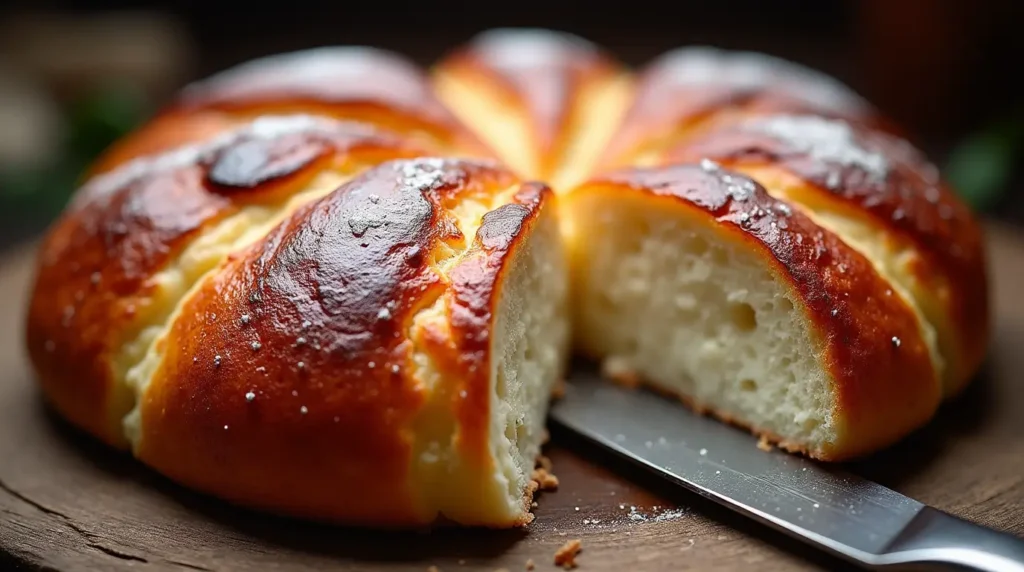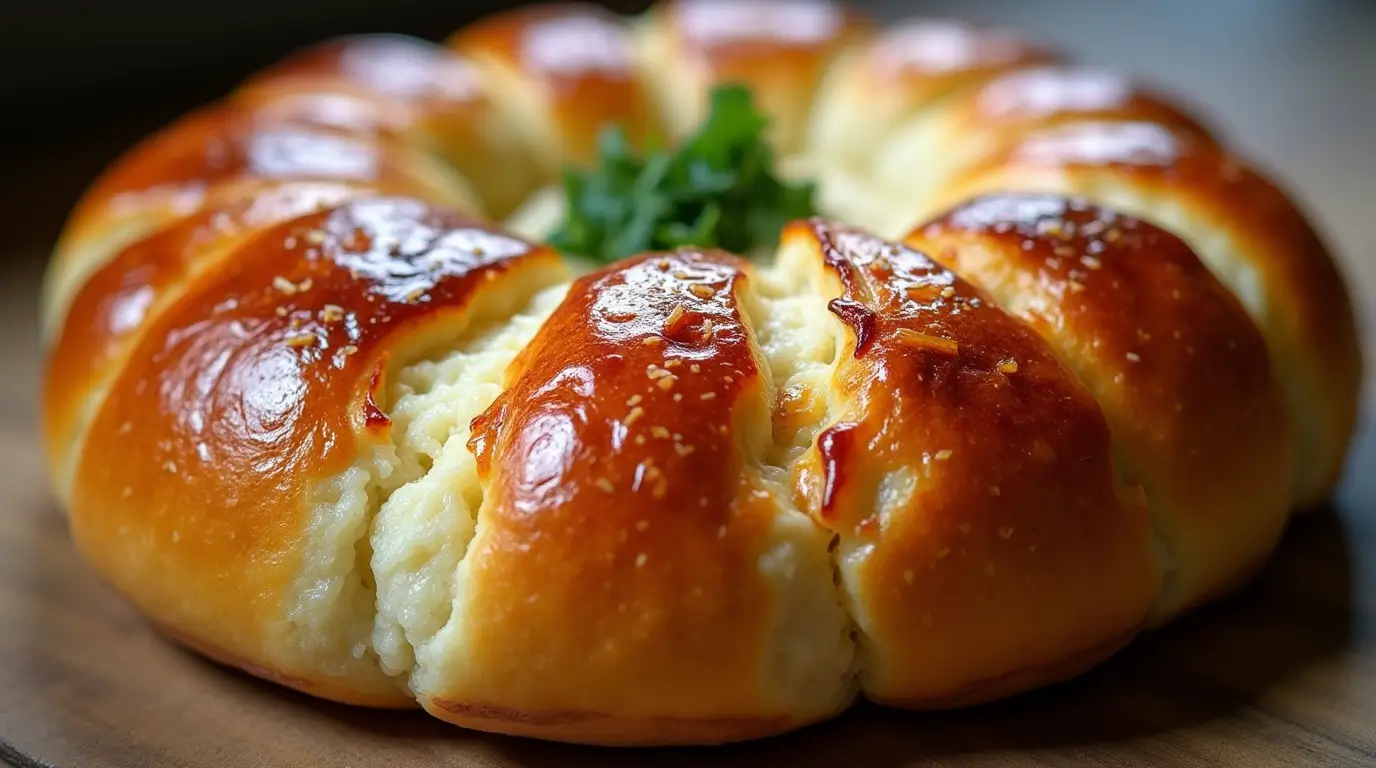Imagine a hot summer day and a kitchen that’s even hotter. Now, think about warm, fresh bread without using your oven. That’s the magic of no oven stove top bread. It’s perfect for when you’re short on time or want something simple.
With this method, you can make soft, golden loaves right on your stovetop. Try Taste of Home’s sourdough-inspired crust or the dough that rises in a skillet. It’s all about making bread easy and full of flavor.
No need for oven preheating or big equipment. Just a pot, a skillet, and some patience. It’s like kneading dough by hand, with each step a victory. From mixing warm milk and yeast to the golden finish, you’re creating something special.
This isn’t just a recipe; it’s a way to connect with baking’s basics. You’re making something real, one pan at a time.
Table of Contents
Introduction to No-Oven Stove Top Bread
Stove-top bread is a game-changer for busy kitchens. It skips the oven and uses just a stovetop to make fluffy loaves in under an hour. Sites like Taste of Home and BuzzFeed call it a must-have for quick bread.
- Speed: No preheating—dough rises and bakes directly in a pot, cutting prep time by 50%.
- Accessibility: Requires only basic pantry staples like flour, water, and salt.
- Texture Control: Hands-on kneading lets you monitor dough development for ideal softness.
Imagine baking bread on a hot summer day without heating your kitchen. Stove-top methods use Dutch ovens or heavy pots to trap steam. This creates a tender interior and flexible crust—no oven required.
This technique gives you full control over ingredients, avoiding preservatives found in store-bought options. It’s perfect for first-time bakers, offering a chance to master artisanal techniques without special equipment. Whether you’re a student in a small apartment or a parent short on time, this method adapts to your lifestyle while delivering restaurant-quality results. Let’s explore how these factors combine to make stove top bread a modern kitchen essential.
Understanding the Ingredients for Perfect Bread
Mastering homemade bread on the stove starts with the right ingredients. Each one affects the bread’s texture, taste, and how it rises. Let’s look at what’s most important.
Flour is the foundation. All-purpose flour gives structure, while whole wheat adds a nutty flavor. For a lighter loaf, mix 70% all-purpose flour with 30% whole wheat flour. Look for gluten content in flour labels; higher gluten flours make bread chewier.
Leavening agents like yeast or baking powder are key for rise. Active dry yeast needs warm water to work (105-115°F). Baking powder doesn’t need proofing. Taste of Home suggests using 1 teaspoon of yeast per cup of flour for good fermentation.
Liquids affect moisture and rise. Water activates enzymes, and milk adds richness. Try adding ¼ of the liquid as apple cider vinegar for a tangy sourdough taste. Adjust liquid amounts by 1-2 tablespoons for your dough’s consistency.
Flavor enhancers like salt, honey, or olive oil balance sweetness and texture. Salt strengthens gluten, and honey enhances browning. Taste tests show that ½ teaspoon of salt per cup of flour is perfect for flavor without being too strong.
Pro tip: Always measure flour by spooning it into the cup—not scooping—to avoid overcompaction. This simple step ensures consistent results every time you make homemade bread on the stove.
Mastering the Stove Top Technique
The Essential Tools for the Job include a heavy skillet or Dutch oven. Lodge cast-iron or All-Clad stainless steel are top choices. They distribute heat well. A tight-fitting lid and a silicone spatula help prevent sticking and ensure the dough rises correctly.
Temperature control is key. Start by preheating the pan on medium-low, then adjust as needed. Cooking at 325–375°F (160–190°C) helps achieve a light texture. High heat can burn the outside and leave the inside raw.
Here’s how to make every batch perfect:
- Grease the pan well with oil or butter.
- Spread the dough evenly, then cover it tightly with the lid.
- Cook 10–15 minutes until the bottom sounds hollow when tapped.
Check the internal temperature with a meat thermometer. Look for 190–200°F (88–93°C) to know it’s done. Rotate the pan halfway for even browning. Let the bread rest in the pan for 5 minutes before cooling on a rack.
These steps work for any quick bread recipe. Try different tools to fit your kitchen. With the right technique and tools, you’ll get great results every time.
Exploring Five Easy No-Oven Bread Recipes
Get creative in your kitchen with Quick Stove Top Bread Variations that don’t need an oven. These recipes show that making homemade bread can be as easy as mixing and cooking in a pot or skillet. Here are five great options for quick weeknight meals or fun weekend projects:
- Pull-Apart Bacon Bread: Mix warm water, yeast, flour, and melted butter. Add crumbled cooked bacon and shape into a ball. Cook in a greased skillet until it puffs up. You’ll get a tasty, crispy treat that’s easy to hold.
- Rustic Cranberry & Orange Loaf: Mix dried cranberries and orange zest into a basic dough. Let it rise, then cook in a cast-iron skillet. Serve warm with butter for a sweet, tangy Quick Stove Top Bread twist.
- Garlic Herb Focaccia: Add minced garlic and dried herbs like rosemary to the dough. Press it into a skillet, make dimples with your fingers, and top with olive oil and herbs before cooking. It’s perfect for dipping.
- Cinnamon Swirl Bread: Roll cinnamon-sugar into the dough before shaping. Cook in a pot until it’s set, then drizzle with a glaze of powdered sugar and milk. It’s a sweet take on classic stove-top bread.
- Whole Grain Multiseed Loaf: Use half oats and flaxseed instead of flour. Add sesame or sunflower seeds. Cook slowly for a dense, hearty loaf that’s great for toasting.
These Quick stove-top bread Variations use common ingredients, making them easy for beginners. Feel free to add cheese, honey, or jalapeños to spice things up. Each recipe focuses on simplicity, so you can have fresh bread in under an hour.
Health and Nutrition Benefits of Homemade Bread
Homemade bread lets you control what goes into your meals. By making bread on the stove top, you pick fresh, whole ingredients. This boosts your diet’s nutritional value. Unlike store-bought bread, your homemade version has no artificial additives.
- Whole grains and fiber: Recipes with whole wheat flour or oats add fiber. This helps with digestion and gives you energy. Taste of Home’s 3-ingredient whole grain loaf has 150 calories per slice.
- Less sodium and sugar: You can cut down on salt and sugar. Taste of Home’s garlic herb recipe has only 100mg of sodium per serving. This is much less than store brands.
- Customizable for diets: You can change flours for gluten-free options like almond flour. Adding chia seeds gives you omega-3s. Vegan recipes use flax eggs instead of dairy.
It’s easy to track what you eat: just adjust oils to cut fat by 40% compared to store-bought. For example, their no-knead sourdough uses olive oil instead of butter. This lowers saturated fats. Baking at home means no mystery ingredients. You only use wholesome basics like yeast, water, and flour.
These choices help you make bread that’s good for your heart or helps with weight management. Every slice is a step toward balanced eating without losing flavor.

Troubleshooting Common Bread-Making Challenges
Even seasoned bakers face Dough Consistency Issues when making stovetop bread. Here’s how to fix common problems and perfect your loaf:
- Sticky dough? Sprinkle a tiny bit of flour on your hands and the pan before shaping. Avoid over-flourishing, which can dry out the dough.
- Dense texture? Check if your dough was under-kneaded. Let it rest for 10 minutes, then gently fold it a few times to build structure.
- Uneven cooking? Rotate the pan halfway through cooking to ensure even heat. Use a lid to trap steam if the top browns too fast.
- Overcooked edges, undercooked center? Lower the heat and cover the pan with a splatter screen to slow cooking and prevent burning.
Adjust the dough consistency by testing hydration levels first. If your recipe feels too dry, add a teaspoon of water at a time. For overly sticky dough, mix in ¼ teaspoon of extra flour. Always work gently—overmixing tightens gluten and creates toughness.
Remember: Stovetop bread relies on hands-on adjustments. Keep a spray bottle of water nearby to mist dough surfaces and a silicone spatula to scrape sticky bits. Practice these fixes, and you’ll master Dough Consistency Issues in no time.
Tips for Customizing Your No-Oven Stove Top Bread
Customizing your no oven stove top bread lets you tailor each loaf to your preferences. Start by experimenting with ingredient swaps. Try substituting buttermilk for regular milk to boost tanginess, or mix in whole-wheat flour for nutty undertones. Even small changes like adding cornmeal to the dough can create a rustic texture.
- Flavor Boosters: Stir in dried rosemary, garlic powder, or cinnamon during mixing. For a sweet twist, fold in raisins or drizzle honey into the dough before shaping.
- Crumbs and Crunch: Add walnuts, sunflower seeds, or flaxseeds to the dough. To coat the crust, dip the shaped dough in water, then press it onto a plate of sesame seeds.
- Texture Tweaks: Make a “soaker” by soaking oats or barley in water for 30 minutes before blending it into the dough. This method prevents dryness and improves digestibility.
- Flavor Depth: Extend fermentation time up to 8 hours. Longer rises develop complex flavors without altering the recipe’s core steps.
Try combining buttermilk and whole-wheat flour for a pull-apart loaf inspired by classic monkey bread recipes. Adjust spices gradually—start with ½ teaspoon of rosemary or ¼ cup of nuts—to avoid overwhelming the base flavor. Whether you crave savory, sweet, or textured variations, these tweaks turn basic dough into a personalized creation.
Enhancing Flavor with Creative Add-Ins
Turn your no-oven bread into a delicious treat by Incorporating Herbs and Spices. You can choose from savory or sweet mix-ins. Fresh herbs, grated cheeses, or toasted seeds make every bite special. Begin by picking ingredients that you love:
- Incorporating Herbs and Spices like rosemary or garlic powder add earthy flavors. Sprinkle dried oregano or thyme into the dough before kneading.
- For a bold taste, use smoked paprika or cumin. Add a teaspoon to your dough for a smoky flavor.
- Crumbled feta or sharp cheddar brings a tangy sharpness. Fold the cheese into the dough gently to avoid overworking.
Be creative with your mix-ins. Try sun-dried tomatoes with basil for a Mediterranean taste or cinnamon with brown sugar for something sweet. Always start with small amounts and adjust to taste. By trying different Incorporating Herbs and Spices, you can make each loaf special and just right for you.
Quick Bread Recipes for Busy Schedules
When time is tight, stove-top breads are a fast fix. They skip the long rise and oven wait, ready in under 30 minutes. Ideal for quick breakfasts or snacks, they use simple steps and common ingredients.
15-Minute Flatbread: Mix 1 cup flour, 1/2 tsp salt, and 3/4 cup warm water into dough. Heat a cast-iron skillet. Roll the dough into a 1/2-inch thick circle. Cook 2-3 minutes per side until golden. Serve with hummus or spreads.
Pancake-Style Sandwich Bread: Whisk 1 1/2 cups milk, 1 egg, and 1 3/4 cups flour until smooth. Heat a nonstick pan. Pour 1/4 cup of batter per pancake. Flip when bubbles form. Stack layers for a quick sandwich base.
5-Minute Microwave Dough: Combine 1 cup instant oatmeal, 1/2 cup milk, and 1 tsp baking powder in a microwave-safe bowl. Microwave on high for 2 minutes. Let cool slightly. Slice into wedges. Toast for extra crispness.
Try adding garlic powder, herbs, or shredded cheese to the dough. Store leftovers in an airtight container. These recipes work with whole wheat or gluten-free flours. No oven is needed—just a stovetop and a 5-minute wait.
Step-by-Step Instructions for Novice Bakers
Start by prepping your dough with these easy steps. First, make sure your workspace is clean. Then, get your ingredients ready: flour, yeast, salt, and warm water.
- Mix dry ingredients: In a bowl, mix 2 cups of all-purpose flour, 1 tsp of salt, and 2 tsp of active dry yeast. Whisk until well combined.
- Combine wet and dry: Add 3/4 cup of warm water (110°F) and 1 tbsp of olive oil. Stir until a sticky dough forms.
- Rest the dough: Cover the bowl with a damp cloth. Let it rest for 10 minutes. This step helps the dough rise.
- Shape and cook: Heat a cast-iron skillet on medium heat. Shape the dough into a ball and place it on the skillet. Cook for 10-12 minutes on each side until it’s golden.
When prepping your dough, don’t over-knead. The dough should be sticky. Avoid adding extra flour. Use a spatula to flip the dough halfway through for even browning.
- Pro tip: Sprinkle cornmeal on the skillet before adding dough for a rustic crust.
- Adjust heat if the bottom burns—lower to medium-low and extend cooking time slightly.
- Let the bread cool on a rack for 5 minutes before slicing for cleaner cuts.
Follow these steps for a simple stove-top loaf in under 30 minutes. Be patient during rest times and handle the dough gently. This way, you’ll avoid a dense loaf. Enjoy your homemade bread warm with butter or as a base for sandwiches!
How to Serve and Enjoy Your Homemade Bread
After baking, follow these tips to enjoy your bread. Proper serving and storage keep it fresh and tasty. Enjoy it at breakfast or as an appetizer.
- Use a serrated knife for clean cuts—angle slices on rustic loaves like sourdough or baguettes for better texture.
- Plate bread on wooden or ceramic boards with accompaniments like olive oil, butter, or cheese for an elegant spread.
For long-term freshness, follow these steps:
- Let the bread cool completely on a wire rack to avoid moisture buildup.
- Store short-term (3 days) in a paper bag or bread box to keep the crust crisp.
- Freeze sliced portions in airtight bags with parchment between slices. Thaw at room temperature or toast directly from frozen to retain texture.
Pair your bread with dishes that enhance its natural flavors. At breakfast, serve toasted with avocado, jam, or as French toast. For lunch, use crusty slices to soak up soups like tomato bisque or hearty stews. Dinner options include pairing with roasted meats or grilled vegetables. As an appetizer, arrange small slices with dips like hummus, olive tapenade, or a cheese platter.
Mastering these best serving practices turns your homemade bread into a centerpiece for every meal. It celebrates both taste and tradition.
Conclusion
Creating no-oven stove-top bread opens up a world of convenience and creativity in your kitchen. You only need a skillet and some pantry staples to make soft, customizable loaves quickly. The recipes we’ve looked at show that you can get big flavor without the hassle of using an oven.
Adding cheese, seeds, or spices lets you make each loaf your own. If your dough doesn’t rise right or sticks, check out the troubleshooting tips. Storing your bread in airtight containers for 2 days or freezing it for months keeps it fresh. These methods not only save energy but also work anywhere, from camping to weeknight dinners.
Now that you know the basics, feel free to experiment. Try making flatbreads or trying new flavors. Share your bread-making adventures online or surprise your loved ones with a homemade loaf. Stove-top baking is all about simplicity and creativity. Your kitchen is full of possibilities, so grab a pan and start making your next loaf today.
FAQ
What are the main benefits of making no oven stove top bread?
Making bread on the stove top saves energy and time. It also keeps your kitchen cool. Plus, you can make delicious, soft bread and try new recipes.
What ingredients do I need for stove-top bread?
You’ll need flour, leavening agents like baking powder or yeast, and liquids like water or milk. You can also add herbs or spices for extra flavor.
How do I manage the temperature for stove-top bread?
Use a heavy-bottomed pan with a tight-fitting lid for even heat. Keep an eye on the heat to avoid burning. Adjust the flame as needed.
Can you recommend some easy no-bake bread recipes?
Yes! Try quick flatbreads, pull-apart bacon bread, or rustic cranberry & orange bread. These recipes are easy and don’t need an oven.
How can I ensure my stove-top bread has the right texture?
Use the right flour and knead the dough well. Understand your stove’s heat. Follow your recipe’s steps for the best results.
What tips do you have for customizing my bread?
Customize your bread by changing ingredients. Add sweeteners, try different flours, or mix in spices and herbs. It’s all about your taste.
Are there any health benefits to making bread at home?
Yes, homemade bread lets you use whole ingredients and control additives. It’s a healthier option that fits your diet.
What common pitfalls should I avoid when making stove-top bread?
Avoid uneven heating, dough that’s too wet or dry, and overcooking. Knowing how to fix these problems will improve your bread.
Can I add creative flavor enhancements to my no-oven bread?
Absolutely! Add fresh herbs, cheeses, or spices for more flavor. Try different combinations to find your new favorites.
What is the best way to store homemade stove-top bread?
Store your bread in a cool, dry place in a sealed container or wrapped in plastic wrap. Freezing it also keeps it fresh for longer.
Did you sample our recipe?
There are no reviews yet. Be the first one to write one.

